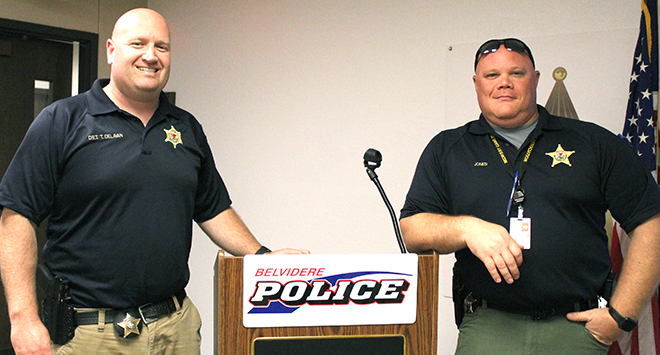Belvidere CPA: Crime Scene and Evidence Collection

ANNE EICKSTADT PHOTO Belvidere Republican
Detective Tom Delevan and Detective Steve Jones inform the citizens in the class how they go about processing a crime scene.
By Anne Eickstadt
The CSI shows on TV skip over ‘boring’ details that, in reality, can make or break a case. They never show all the hours of exacting attention to detail that it can take to process a crime scene correctly. The programs only show the evidence actually being found and race to the exciting parts that keep viewers coming back for more. Also, why do the forensic specialists in the shows race around chasing the bad guys? That part is supposed to be done by the police officers, not the analysts.
Det. Tom Delavan joined Det. Jones in the training room (back for the third time to impart his expertise to the class) for the Belvidere Citizen’s Police Academy. Det. Delavan has been with the Belvidere Police Dept. for 12 years, five of them as a general case detective. “It’s amazing how much technical stuff you have to know,” he said. “We are involved with crime scenes at least once a week.”
Solving cases is usually a team effort. It takes information management, manpower management, technology management, and logistics management. The lead detectives get the basic information, then decide how much help is needed. We might need only a couple of people or we might need to borrow people from the drug team or other departments. Each one is assigned specific jobs, such as taking photos of the crime scene and the evidence, talk to the witnesses, etc.
We might have a major crime with minimum evidence or we might have a minor crime with tons of evidence. The ‘CSI effect’ is the unrealistic expectations of the jurors from watching the TV shows. They think irrefutable evidence will be available in every case. They don’t realize that in real life it can take up to nine months to get fingerprint results from AFIS. Instant results are only found on television shows.
We place a marker everywhere we will be searching,” said Det. Delavan. “We take pictures going in so we know what the scene looks like before anyone touches it. We take exit pictures going out so we know how it looked when we finished. We take pictures as we find stuff. We place a T-square or something next to footprints to have an accurate way to tell how big it is. If we do not have a T-square handy, we can use a dollar bill, or a coin, or something that has a uniform size to determine the length and breadth of the print or piece of evidence.
“We speak to victims. We speak to offenders. We look for and speak to witnesses.
We download cell phones and check for all available evidence,” said Det. Delevan. “Smart phones are essentially computers and we can learn a lot from them. Our cases are becoming more and more involved. Technology and the Internet are a new kind of crime scene. It takes a lot of our time tracking people down.”
“We also have to preserve all physical evidence properly,” said Det. Jones. “If a shirt is soaked in blood, we cannot put it in a plastic bag. It would get moldy. We have to dry it out first and we have a place we can do that properly. Then we will place it in an evidence bag. We use a lot of cardboard boxes and paper bags so that evidence can breathe.
“Initially we are looking for probable cause to make an arrest. For major crimes, we will get a search warrant so we can secure the property until we are completely done with it. By the time the court case comes up, we need to have evidence that is beyond a reasonable doubt to present to the court in proving the case.
“We have to be very methodical and document everything in our reports. They can get very long and very dry with a narrative description of the scene and step-by-step descriptions of what we did, but we have a saying – ‘If it’s not in the report, it didn’t happen.’
“When police arrive on the scene, they assist the victim(s), search for/arrest suspect(s), separate and interview witnesses, protect and process the crime scene, and maintain evidence throughout the court procedure.
“We work with a belief in Locard’s exchange principle. It holds that the perpetrator of a crime will bring something into the crime scene and leave with something from it, and that both can be used as forensic evidence. That’s why we protect crime scenes. We use the crime scene tape to protect it from contamination from bystanders, witnesses, news reporters, and even other police officers.”
Some cases fall into place quickly while others are never solved. The detectives keep working and learning and doing the best they can to find enough evidence to identify and convict those who are a danger to the community.



